Is There A Flavor Difference Between Black And White Cardamom?
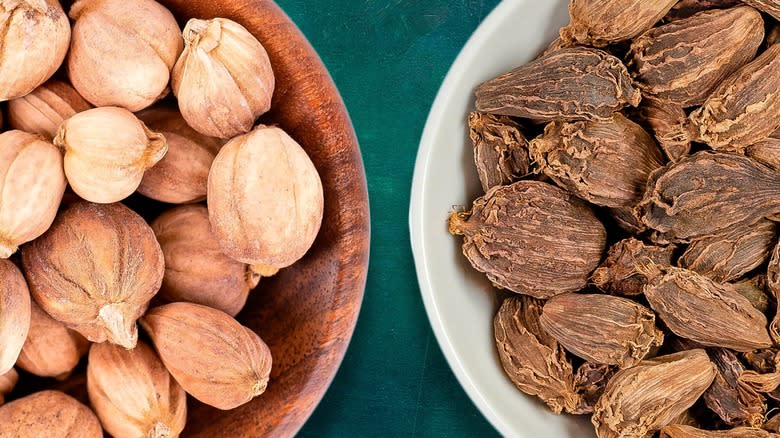
Cardamom is a special spice belonging to the same family as ginger. These aromatic pod spices can be toasted whole or ground up. Either way, they bring a magical warming effect to your meals. Something that makes cardamom so special is that it can be used in both savory dishes, such as curries, or sweeter dishes like pastries. Cardamom can even be added to your morning coffee if you so please. Beyond cooking, this spice has also effectively been used as a way to clean your teeth. With such versatility, it's easy to see why it's so coveted in the world of spices and favored by chefs like Nadiya Hussain.
Within cardamom, there are variations based on color: green, black, and white. Green and white cardamom are essentially the same thing; white cardamom is just green cardamom that has been bleached and made mild. Black cardamom, meanwhile, comes from a different plant and offers a bolder flavor. Though black and white cardamom may seem somewhat similar at first glance, the flavors and correct uses for each type are not the same -- and the differences go far beyond just color.
The nuances of each type are just another reason why this spice is so magical. When learning how to cook with cardamom, you want to get the most out of it so you can enjoy the "queen of spices" in all its glory, and knowing the differences between these two types helps.
Read more: The 20 Best Olive Oils For Cooking
What Is White Cardamom?
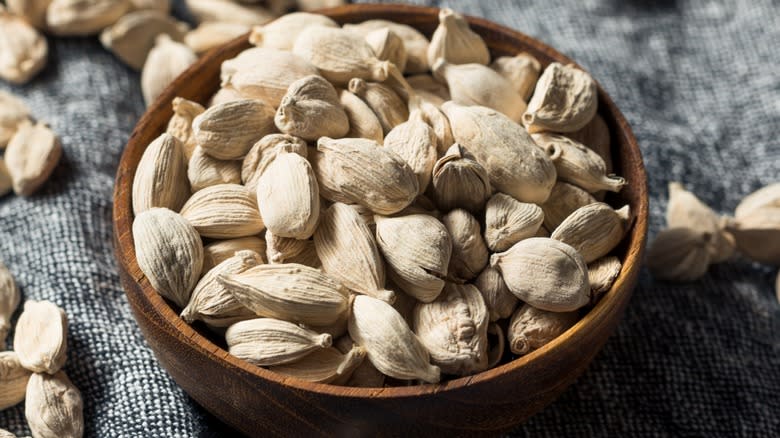
White cardamom is just green cardamom, also called true cardamom, that's been bleached. While the bleaching doesn't majorly affect the spice too much beyond coloring, it does fade the flavors a little bit. White cardamom comes both whole and ground. It is milder in flavor than both green and black cardamom and is favored in Scandinavian countries for this very reason. It is also still prevalent in Middle Eastern countries and some Asian countries.
These pods come from the plant Elettaria cardamomum and thrive in tropical climates. White cardamom is what you'll most likely find at the grocery store and it has the most traditional cardamom taste. In terms of savory or sweet, it works for both but is mostly prized for the unique flavor it brings to desserts. When used in its whole form, white cardamom is excellent in stews, curries, and other slow-cooked meals. When cardamom is sold as a ground spice, the shells are removed and the seeds inside are pulverized into the familiar powder.
What Is Black Cardamom?
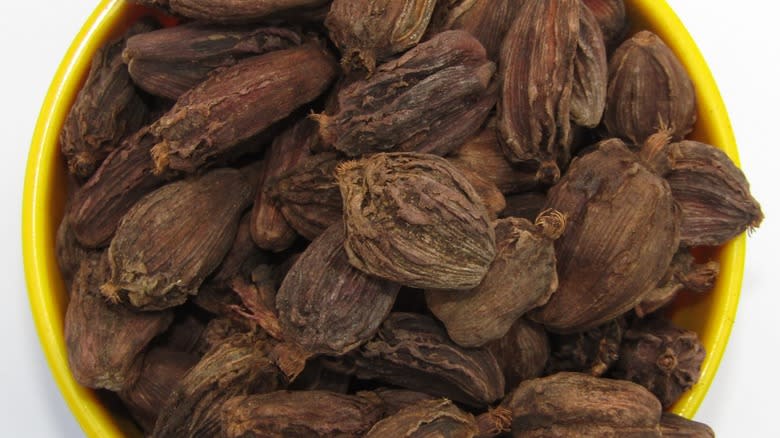
Black cardamom, also called big cardamom and Nepal cardamom, is a different species than the typical grocery store variety of the spice. Its pods come from the plant Amomum subulatum, which is native to India and Nepal. Black cardamom pods are dark and wrinkly, with sticky seeds on the inside. Perhaps the most pungent variety, it is used mostly in savory dishes, where it is prized for its smoky, woodsy, and menthol-like flavor. Some even say it has a meaty, umami taste.
Black cardamom is commonly used whole in its pod form, but you can occasionally find it ground at specialty markets. Unlike the white variety, you cannot eat the pods of black cardamom, though the seeds within are edible. It often makes an appearance in spice blends such as garam masala and Tandoori spices. While not as commonly seen in American grocery stores as white cardamom, black cardamom is crucial for giving dishes warmth and intense flavor.
White Cardamom Tastes Fresh And Sweet
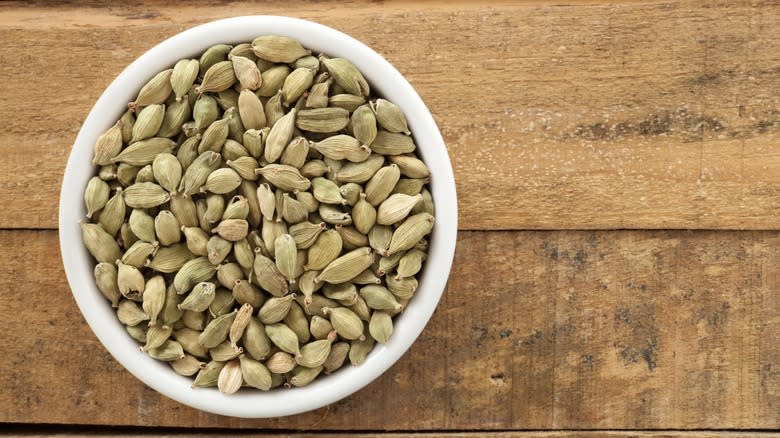
The tasting notes of white cardamom include mint, herbal bitterness, cloves, and hints of citrus. When bleached, the flavors mellow out and develop a lightly sweetened taste. The fresher flavors of white cardamom make it better suited to lighter or sweeter dishes. While both color types hail from the same family as ginger, white cardamom is closer in flavor to the spicy root. As a result, white cardamom is a popular ingredient replacement for ground ginger and vice versa. The way both forms of cardamom bring warmth to a dish is different, as well.
White cardamom brings a comforting spice effect, similar to a pumpkin spice blend. Black cardamom, meanwhile, brings the illusion of warmth thanks to its smokiness. This flavor gives black cardamom a heavier feel in dishes. When coupled with the fact that it has such a strong aroma, it makes sense why this spice goes well with savory food. If you're looking to really taste the cardamom in a dish, you're better off choosing black cardamom for that powerful spice taste. But if you want a more subtle cardamom note, then white cardamom is better suited for your needs.
Black Cardamom Is Tougher And More Variable
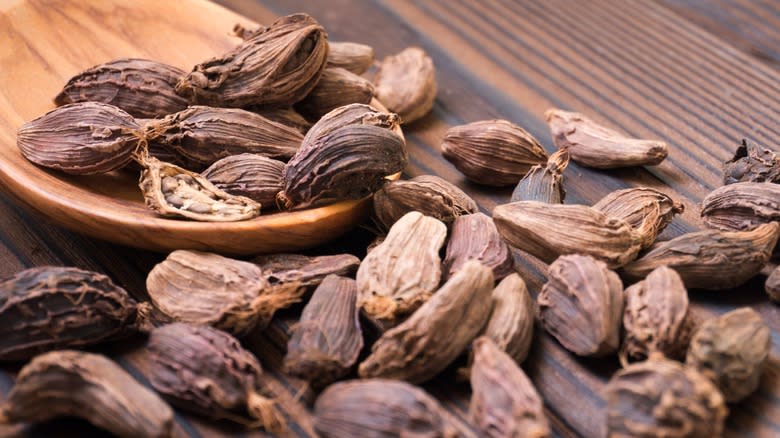
Perhaps the biggest distinction between white and black cardamom is their appearance. White cardamom in its whole form looks like green cardamom seeds but has an almost dusty outer shell and a slightly smaller shape as a result of the bleaching. After being bleached, the outer green husk is stripped away leaving only the seed behind. The uniformity of white cardamom is an important factor for its uses, so you won't find too much variation from seed to seed.
Black cardamom, on the other hand, can vary slightly in terms of how dark it gets. It is larger than white cardamom and tougher, too. The strong, wrinkled skin on it comes from the drying stage of the pods. This hard outer shell is another contributor to why you typically won't find black cardamom pre-ground. And don't forget to take it out of your dishes before serving, or you might risk chipping a tooth.
White Cardamom Is Picked Before Maturity And Bleached
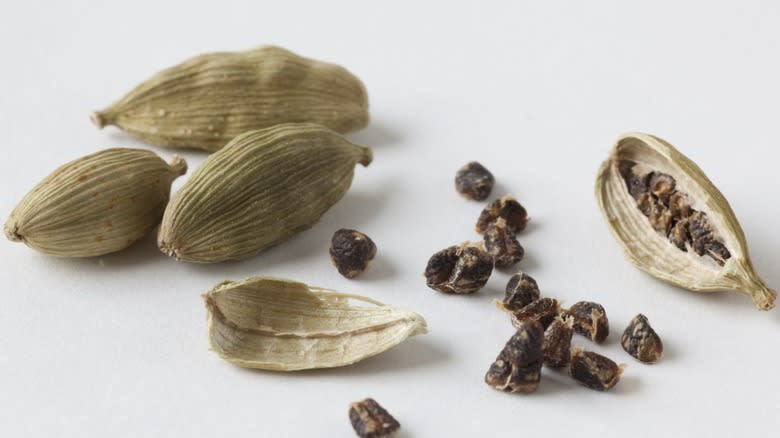
As mentioned, white cardamom gets its unique appearance from the bleaching process it undergoes after harvest. Green cardamom pods are picked just before being ripe. There are then two main ways to bleach these pods.
The first is through natural sun exposure, in which the pods are laid out on a concrete slab and the heat of the sun fades and dehydrates them. This method is most successful in locations with a dry, warm climate. Alternatively, a solar dryer is used for a more controlled bleaching process. This device contains the pods and controls the environment, and an extractor fan can be added to create a drier atmosphere.
Black cardamom pods, meanwhile, are harvested at full maturity to ensure a more intense flavor. The pods get their smoky notes due to the unique processing method they undergo. Black cardamom is often dried over a low, open flame, a practice that is especially common in India. As the smoke dries out the black cardamom pods, it infuses the spice with a burnt, smoky flavor.
Black Cardamom Is Harder To Find At Grocery Stores
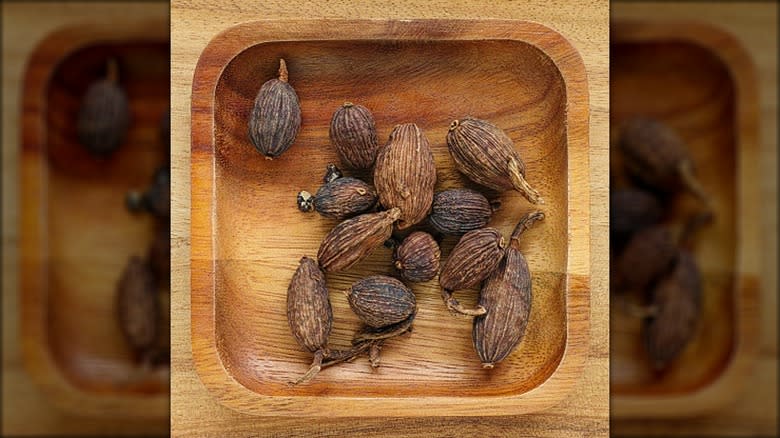
When you walk down the spice aisle of your local grocery store, the cardamom you can find there is most likely ground white cardamom. Another common form you'll find cardamom in at stores is as bleached, whole white seeds. Since white cardamom is more popular across many different cuisines and dishes, offering the uniform white pods makes using cardamom more user-friendly. This consistent hue is part of why white cardamom is so popular since it won't impact the color of baked goods. Most likely if a recipe is calling for cardamom, it's referring to white cardamom.
A recipe will specifically call for black cardamom if it is needed in the dish. If you find that you need black cardamom, your best chance at finding it is going to be at South Asian specialty markets, Indian specialty markets, and general Asian markets. Some spice stores might carry black cardamom, as well. This is because it is grown in fewer regions compared to white cardamom. Whenever you purchase either type, it's important to store your spices in an airtight container and away from sunlight, especially white cardamom that has already faded due to bleaching.
Read the original article on Tasting Table

 Yahoo News
Yahoo News 
